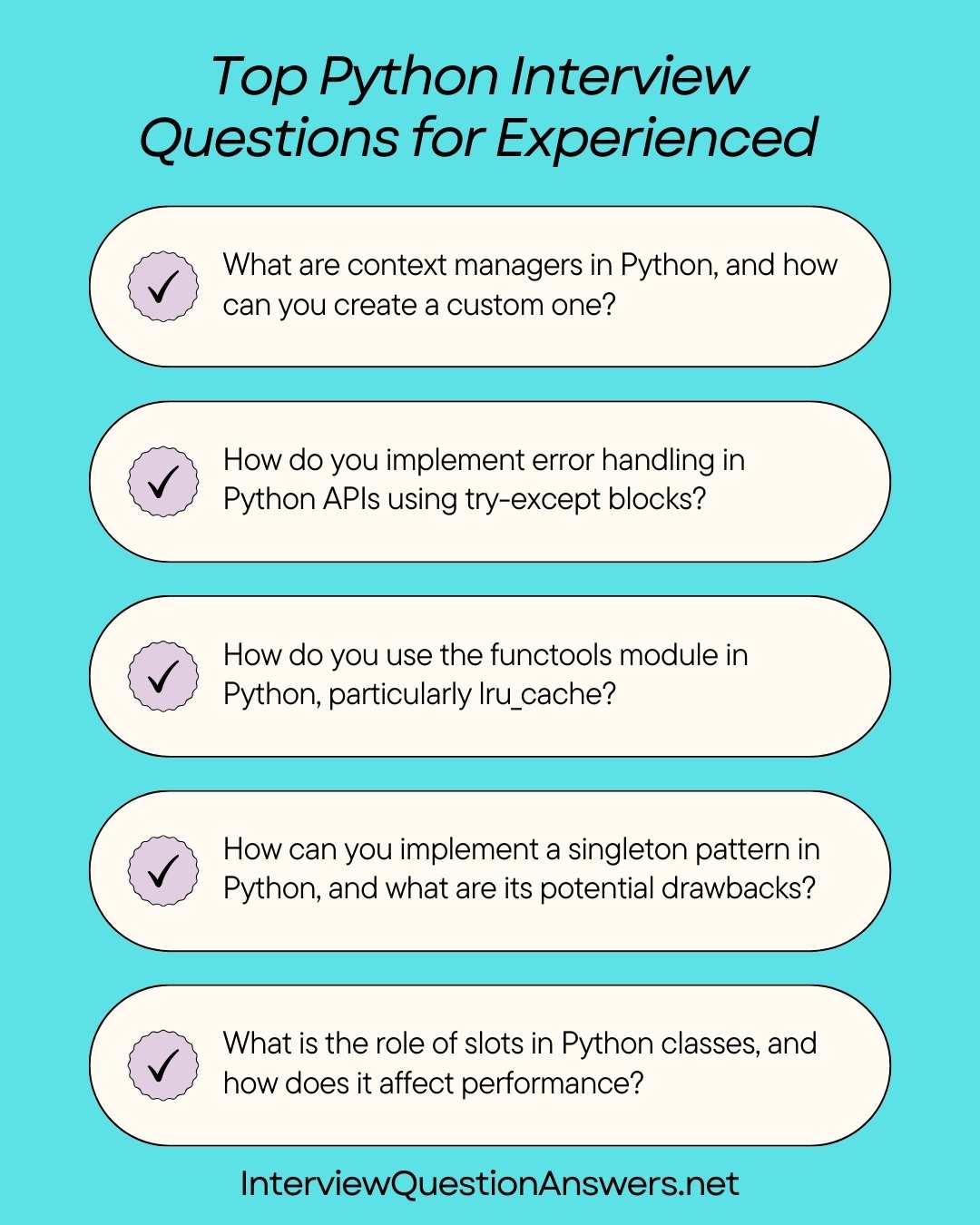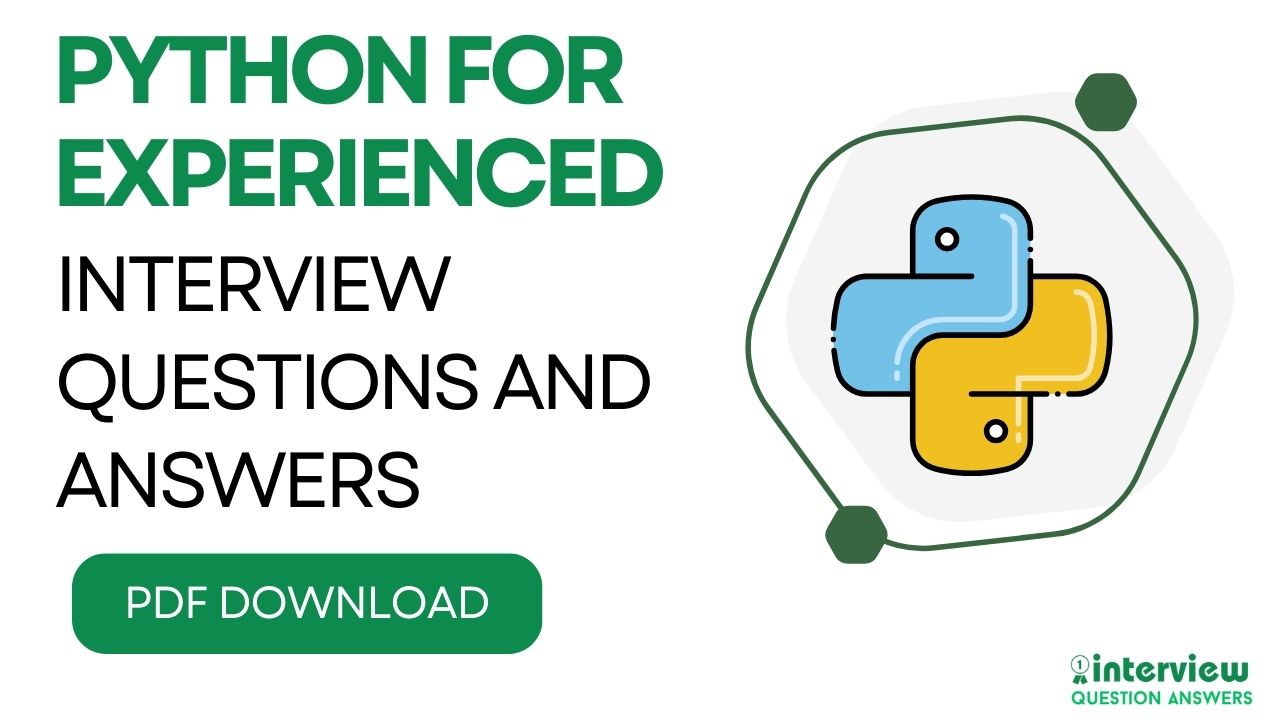Top Python Interview Questions for Experienced 2025
Python interview Questions guide helps experienced developers prepare for senior-level programming job interviews with the most challenging questions that companies ask seasoned professionals. We included advanced Python questions about complex programming concepts, system architecture, and real-world problems that experienced developers encounter in their daily work.
This Python Interview Questions for Experienced article covers everything from advanced Python features and performance optimization to frameworks and large-scale project management that employers expect from senior candidates. We made sure to include questions about Python libraries, database integration, web development, and team leadership responsibilities that experienced developers must handle.
Each question comes with comprehensive answers that demonstrate multiple solution approaches and explain why certain implementations work better than others. The questions progress in difficulty throughout the guide, starting with intermediate-level topics and advancing to expert-level concepts that only senior developers typically master.
Table of Contents
Python Interview Questions for 2 Years Experience
Que 1. How does Python’s Global Interpreter Lock (GIL) affect multi-threading, and what are its implications?
Answer: The Global Interpreter Lock (GIL) in Python is a mutex that protects access to Python objects, preventing multiple native threads from executing Python bytecode simultaneously in a single process. This means that only one thread can execute Python code at a time, limiting the effectiveness of multi-threading for CPU-bound tasks. For I/O-bound tasks, like network calls or file operations, multi-threading can still be effective as threads can release the GIL during I/O operations.
The GIL simplifies memory management but can be a bottleneck in multi-core systems for CPU-intensive tasks. Developers with 2 years of experience often use multiprocessing or asynchronous programming (e.g., asyncio) to bypass GIL limitations for parallel execution.
Que 2. What is the difference between a Python module and a package?
Answer:
| Feature | Module | Package |
|---|---|---|
| Definition | A single .py file with code | A directory with __init__.py and multiple modules |
| Purpose | Contains functions, classes, etc. | Organizes multiple modules |
| Import Example | import mymodule | import mypackage.mymodule |
A module is a single Python file containing code, while a package is a directory containing an __init__.py file and multiple modules or sub-packages. Packages allow better organization and namespace management for larger projects.
Que 3. How can you optimize a Python program for better performance?
Answer: To optimize a Python program, you can use efficient data structures (e.g., sets for lookups instead of lists), leverage built-in functions like map() or list comprehensions instead of loops, and avoid unnecessary object creation. Profiling tools like cProfile help identify bottlenecks.
For CPU-bound tasks, consider multiprocessing to utilize multiple cores or libraries like NumPy for faster numerical computations. Using compiled extensions (e.g., Cython) or just-in-time compilers (e.g., PyPy) can also improve performance. Caching results with tools like functools.lru_cache is effective for repetitive computations.
Que 4. What are context managers in Python, and how can you create a custom one?
Answer: Context managers in Python manage resources (e.g., files, database connections) by ensuring setup and cleanup, typically used with the with statement. They implement __enter__ and __exit__ methods to handle resource allocation and release. To create a custom context manager, define a class with these methods or use the @contextlib.contextmanager decorator with a generator function.
Example:
from contextlib import contextmanager
@contextmanager
def temp_file():
print("Creating file")
try:
yield "temp.txt"
finally:
print("Cleaning up file")Que 5. How do you handle memory management in Python, and what role does the garbage collector play?
Answer: Python’s memory management relies on reference counting and a cyclic garbage collector. Reference counting tracks the number of references to an object, freeing memory when the count reaches zero. The garbage collector, implemented in the gc module, handles cyclic references (e.g., objects referencing each other) by periodically detecting and collecting them.
Developers can optimize memory by avoiding circular references, using weak references (weakref), or manually triggering garbage collection with gc.collect(). Understanding memory management helps with 2 years of experience in optimizing resource-heavy applications.
Que 6. What is the purpose of the asyncio library in Python, and how does it support asynchronous programming?
Answer: The asyncio library in Python enables asynchronous programming, allowing tasks to run concurrently without blocking, ideal for I/O-bound operations like network requests. It uses an event loop to manage coroutines, defined with async def and executed with await. The library supports tasks, futures, and async/await syntax for non-blocking code. For example, asyncio.run() executes an async program, and asyncio.gather() runs multiple coroutines concurrently. It’s useful for developers with 2 years of experience building scalable, I/O-heavy applications.
Que 7. How do you implement error handling in Python APIs using try-except blocks?
Answer: In Python APIs, error handling with try-except blocks ensures robust responses to client requests. Wrap API logic in a try block to catch exceptions like ValueError, TypeError, or custom exceptions. Use except to handle specific errors, returning meaningful HTTP status codes and messages (e.g., 400 for bad input, 500 for server errors).
The else block can handle successful cases, and finally ensures cleanup. For example, in a Flask API, catch database errors and return JSON responses with error details, improving reliability for production systems.
Que 8. What are Python’s metaclasses, and how are they used?
Answer: Metaclasses in Python are classes that define the behavior of other classes, acting as a “class of a class.” The default metaclass is type, but you can create a custom metaclass by inheriting from type and overriding methods like __new__ or __init__.
They are used to modify class creation, such as adding attributes or enforcing constraints. For example, a metaclass can ensure all classes have a specific method. Developers with 2 years of experience might use metaclasses in frameworks like Django for ORM behavior.
Example:
class MetaClass(type):
def __new__(cls, name, bases, attrs):
attrs['custom_method'] = lambda self: "Added by metaclass"
return super().__new__(cls, name, bases, attrs)
class MyClass(metaclass=MetaClass):
pass
obj = MyClass()
print(obj.custom_method()) # Outputs: Added by metaclassQue 9. How do you use the functools module in Python, particularly lru_cache?
Answer: The functools module in Python provides higher-order functions, with lru_cache being a decorator that caches function results to improve performance for expensive computations. It stores results in a Least Recently Used (LRU) cache, avoiding redundant calculations for the same inputs. For example, applying @functools.lru_cache to a recursive Fibonacci function reduces time complexity by memoizing results. Developers with 2 years of experience use it to optimize functions with repetitive calls.
Example:
from functools import lru_cache
@lru_cache(maxsize=128)
def fibonacci(n):
if n < 2:
return n
return fibonacci(n-1) + fibonacci(n-2)Que 10. What is the difference between getattr and getattribute in Python?
Answer: In Python, __getattr__ and __getattribute__ are special methods for attribute access, but they differ in behavior:
__getattr__: Called when an attribute is not found through normal lookup, acting as a fallback.__getattribute__: Called for every attribute access, regardless of whether the attribute exists, allowing full control over attribute lookup.
Example:
class MyClass:
def __getattr__(self, name):
return f"Attribute {name} not found"
def __getattribute__(self, name):
return object.__getattribute__(self, name)
obj = MyClass()
print(obj.unknown) # Outputs: Attribute unknown not foundFor developers with 2 years of experience, understanding these methods is key for customizing object behavior, such as in dynamic attribute handling or proxy classes.
Python Interview Questions for 3 Years Experience
Que 11. How does Python’s memory management handle circular references, and what tools can you use to detect memory leaks?
Answer: Python’s memory management uses reference counting as the primary mechanism, but circular references (where objects refer to each other) prevent counts from reaching zero. The garbage collector (gc module) periodically runs to detect and break these cycles using a generational approach, focusing on newer objects first. To detect memory leaks, you can use tools like objgraph for visualizing object graphs, memory_profiler for line-by-line memory usage, or tracemalloc to trace allocations. For 3 years of experience, understanding manual intervention with gc.collect() or weak references (weakref) is crucial for optimizing long-running applications.
Que 12. What are the key differences between coroutines and threads in Python, and when would you choose one over the other?
Answer:
| Feature | Coroutines | Threads |
|---|---|---|
| Execution Model | Cooperative, user-level | Preemptive, OS-level |
| Overhead | Low, no context switching | Higher, context switching |
| Scalability | High for I/O-bound tasks | Limited by GIL for CPU-bound |
| Use Case | Async I/O (e.g., asyncio) | Parallel I/O or simple concurrency |
Coroutines are preferred for I/O-bound tasks due to efficiency and scalability, while threads suit scenarios needing true parallelism with multiprocessing fallback for CPU-bound work.
Que 13. How can you implement a singleton pattern in Python, and what are its potential drawbacks?
Answer: A singleton pattern ensures a class has only one instance. In Python, you can implement it by overriding __new__ to return the same instance or using a metaclass to control creation.
Example:
class Singleton:
_instance = None
def __new__(cls):
if cls._instance is None:
cls._instance = super().__new__(cls)
return cls._instanceDrawbacks include global state issues, testing difficulties, and tight coupling, which can complicate multi-threaded environments. For 3 years of experience, consider module-level variables as a simpler alternative.
Que 14. What is the purpose of Python’s dataclasses module, and how does it simplify class definition?
Answer: The dataclasses module, introduced in Python 3.7, simplifies defining classes for storing data by automatically adding methods like __init__, __repr__, __eq__, and __hash__ based on class attributes. It reduces boilerplate code for data-centric classes.
Example:
from dataclasses import dataclass
@dataclass
class Point:
x: int
y: int
p = Point(1, 2)
print(p) # Outputs: Point(x=1, y=2)It supports default values, type hints, and custom methods, making it ideal for immutable data structures or DTOs in applications.
Que 15. How do you use Python’s concurrent.futures module for parallel execution, and what are its advantages over threading?
Answer: The concurrent.futures module provides a high-level interface for asynchronous execution using thread or process pools. Use ThreadPoolExecutor for I/O-bound tasks and ProcessPoolExecutor for CPU-bound tasks to bypass GIL.
Example:
from concurrent.futures import ThreadPoolExecutor
def task(n):
return n * n
with ThreadPoolExecutor() as executor:
results = list(executor.map(task, range(10)))Advantages include simpler API, automatic handling of futures, and better scalability for parallel tasks compared to raw threading.
Que 16. What are Python’s abstract base classes (ABCs), and how do you use the ABC module to create them?
Answer: Abstract base classes (ABCs) define interfaces or base classes with abstract methods that must be implemented by subclasses. The abc module provides ABC and @abstractmethod for this purpose.
Example:
from abc import ABC, abstractmethod
class Shape(ABC):
@abstractmethod
def area(self):
pass
class Rectangle(Shape):
def __init__(self, width, height):
self.width = width
self.height = height
def area(self):
return self.width * self.height
ABCs enforce contracts, aiding in design patterns and type checking.
Que 17. How can you profile Python code for performance bottlenecks, and what tools would you recommend?
Answer: Profiling identifies slow parts of code. Use cProfile for CPU profiling, running it with python -m cProfile script.py or programmatically. For memory, memory_profiler decorates functions with @profile. Recommend line_profiler for line-by-line analysis and py-spy for sampling profilers in production. Visualize with snakeviz or gprof2dot. For 3 years of experience, combining profiling with optimization techniques like vectorization is key.
Que 18. What is the role of slots in Python classes, and how does it affect performance?
Answer: __slots__ in Python classes defines a fixed set of attributes, reducing memory usage by avoiding the __dict__ dictionary for instance variables. It improves attribute access speed and prevents dynamic attribute addition.
Example:
class Point:
__slots__ = ['x', 'y']
def __init__(self, x, y):
self.x = x
self.y = yIt’s beneficial for memory-intensive applications with many instances, but limits inheritance and dynamic attributes.
Que 19. How do you implement asynchronous I/O in Python using asyncio, including error handling?
Answer: asyncio enables async I/O with coroutines. Use async def for functions, await for blocking calls, and asyncio.run() to execute. For error handling, wrap in try-except within coroutines, or use asyncio.gather() with return_exceptions=True to collect errors.
Example:
import asyncio
async def fetch_data():
try:
await asyncio.sleep(1)
return "Data"
except Exception as e:
return f"Error: {e}"
async def main():
results = await asyncio.gather(fetch_data(), fetch_data(), return_exceptions=True)
print(results)
asyncio.run(main())This supports scalable, non-blocking code for web servers or APIs.
Que 20. What are Python’s type hints, and how do you use tools like mypy for static type checking?
Answer: Type hints in Python (PEP 484) annotate code with types (e.g., def add(a: int, b: int) -> int:) to improve readability and catch errors. They don’t affect runtime but enable static analysis. Use mypy by installing it (pip install mypy) and running mypy script.py to check for type inconsistencies. For 3 years of experience, integrating type hints with IDEs like VS Code enhances development, especially in large codebases.

Python Interview Questions for 5 Years Experience
Que 21. How do you use the itertools module in Python to optimize iterative tasks?
Answer: The itertools module in Python provides efficient tools for working with iterators, optimizing tasks like combinations, permutations, and grouping. Common functions include itertools.chain() for flattening iterables, itertools.combinations() for generating combinations, and itertools.groupby() for grouping data. For example, itertools.chain.from_iterable() can flatten a list of lists efficiently. These functions are memory-efficient as they return iterators, ideal for large datasets. Developers with 3 years of experience use itertools to simplify complex iterations and improve performance in data processing tasks.
Que 22. What is the difference between a Python generator expression and a list comprehension, and when would you use each?
Answer:
| Feature | Generator Expression | List Comprehension |
|---|---|---|
| Syntax | (x for x in iterable) | [x for x in iterable] |
| Memory Usage | Lazy evaluation, low memory | Eager evaluation, full list in memory |
| Output | Returns a generator | Returns a list |
| Use Case | Large datasets, streaming | Small datasets, immediate use |
Example:
gen = (x**2 for x in range(1000000)) # Memory-efficient
list_comp = [x**2 for x in range(1000)] # Immediate listUse generator expressions for memory-intensive tasks; use list comprehensions for smaller, immediate results.
Que 23. How can you implement a custom iterator in Python using iter and next?
Answer: A custom iterator in Python is created by defining a class with __iter__ (returns the iterator object) and __next__ (returns the next item or raises StopIteration). This allows iteration over custom data structures. For 3 years of experience, implementing custom iterators is useful for specialized data traversal in applications like data pipelines.
Example:
class MyRange:
def __init__(self, start, end):
self.current = start
self.end = end
def __iter__(self):
return self
def __next__(self):
if self.current >= self.end:
raise StopIteration
value = self.current
self.current += 1
return valueQue 24. What is the purpose of Python’s logging module, and how does it compare to print() for debugging?
Answer: The logging module in Python provides a flexible way to log messages with levels (DEBUG, INFO, WARNING, ERROR, CRITICAL), timestamps, and output destinations (e.g., console, files). Unlike print(), it supports log levels, formatting, and persistence, making it suitable for production. For example, logging.info("Message") logs with context, while print() is simple but lacks structure. Developers with 3 years of experience use logging for debugging and monitoring in production systems, configuring handlers for different outputs.
Que 25. How do you use Python’s unittest framework to write and run tests?
Answer: The unittest framework in Python supports automated testing by defining test cases in classes that inherit from unittest.TestCase. Methods starting with test_ are executed as tests, using assertions like assertEqual(). Run tests with unittest.main() or via command line (python -m unittest). For 3 years of experience, writing robust tests with setup (setUp) and teardown (tearDown) methods ensures code reliability in larger projects.
Example:
import unittest
class TestMath(unittest.TestCase):
def test_add(self):
self.assertEqual(1 + 1, 2)Que 26. What are Python’s descriptors, and how can you implement a custom descriptor?
Answer: Descriptors in Python are objects that define how attribute access is handled, using __get__, __set__, or __delete__. They are used in frameworks like Django for ORM fields. A custom descriptor controls attribute behavior, such as validation.
Example:
class PositiveNumber:
def __set_name__(self, owner, name):
self.name = name
def __get__(self, obj, objtype=None):
return getattr(obj, f"_{self.name}")
def __set__(self, obj, value):
if value < 0:
raise ValueError("Must be positive")
setattr(obj, f"_{self.name}", value)
class Item:
price = PositiveNumber()Descriptors allow fine-grained control over attribute access, useful for reusable validation logic.
Que 27. How do you handle file I/O efficiently for large files in Python?
Answer: For large files, Python’s file I/O can be optimized by reading/writing in chunks (e.g., using read(size) or readline()), using with for automatic closure, or leveraging mmap for memory-mapped files. Generators can yield lines to minimize memory usage. For example, with open('file.txt', 'r') as f: for line in f: processes one line at a time. Developers with 3 years of experience use these techniques to handle large datasets without loading entire files into memory.
Que 28. What is the role of Python’s SYS module in system-specific operations?
Answer: The sys module in Python provides access to system-specific parameters and functions, such as sys.argv for command-line arguments, sys.path for module search paths, and sys.exit() for program termination. It’s used to manipulate runtime environments, like adding directories to sys.path or checking Python version with sys.version. For 3 years of experience, sys is useful for scripting and debugging system-level interactions.
Example:
import sys
sys.path.append('/custom/path')Que 29. How do you use Python’s json module to serialize and deserialize data?
Answer: The json module in Python serializes Python objects to JSON (using json.dump or json.dumps) and deserializes JSON to Python objects (using json.load or json.loads). It supports basic types (lists, dictionaries, strings) and custom objects with a JSON encoder/decoder. For 3 years of experience, handling JSON in APIs or configuration files is common.
Example:
import json
data = {"name": "Alice", "age": 25}
with open('data.json', 'w') as f:
json.dump(data, f)Que 30. How can you implement a basic REST API client in Python using the requests library?
Answer: The requests library in Python simplifies HTTP requests for REST API interactions. Use requests.get() for retrieving data, requests.post() for sending data, and handle responses with status codes and JSON parsing. For 3 years of experience, error handling and authentication (e.g., API keys) are key.
Example:
import requests
response = requests.get('https://api.example.com/users')
if response.status_code == 200:
print(response.json())Python Interview Questions for 10 Years Experience
Que 31. How do you optimize Python code for high-performance computing, particularly for CPU-bound tasks?
Answer: For CPU-bound tasks, Python’s performance can be optimized by bypassing the Global Interpreter Lock (GIL) using multiprocessing to leverage multiple cores, as it spawns separate processes. Libraries like NumPy and Cython accelerate numerical computations by using compiled code. Just-in-time compilation with PyPy can significantly speed up execution compared to CPython.
Profiling with cProfile or py-spy identifies bottlenecks, and techniques like vectorization or parallel processing with joblib distribute workloads. For 10 years of experience, combining these with low-level optimizations, such as minimizing object allocations or using memory-efficient data structures, is critical for high-performance systems like scientific computing or machine learning.
Que 32. What are the challenges of using Python in a microservices architecture, and how can you address them?
Answer: Challenges in Python microservices include performance overhead due to the GIL, higher memory usage compared to languages like Go, and dependency management complexity. Address these by:
- Using
multiprocessingorasynciofor concurrency. - Containerizing services with Docker for isolation and scalability.
- Employing dependency management tools like
PoetryorPipenvto avoid conflicts. - Implementing lightweight frameworks like FastAPI for low-latency APIs.
- Monitoring with tools like Prometheus and Grafana to track performance.
For 10 years of experience, ensuring robust CI/CD pipelines and service orchestration with Kubernetes enhances reliability and scalability.
Que 33. How do you implement a custom memory-efficient data structure in Python?
Answer: A custom memory-efficient data structure, like a sparse array, can be implemented using a dictionary or array.array to store only non-default values, reducing memory footprint. For example, a sparse array for numerical data can use a dictionary to map indices to values, avoiding storage of zeros. Use __slots__ in classes to eliminate __dict__ overhead, or leverage numpy for compact arrays. For 10 years of experience, optimizing with struct for packed binary data or mmap for disk-backed storage ensures scalability in memory-constrained environments.
Example:
class SparseArray:
def __init__(self):
self.data = {} # Store only non-zero values
def __setitem__(self, index, value):
if value != 0:
self.data[index] = value
elif index in self.data:
del self.data[index]
def __getitem__(self, index):
return self.data.get(index, 0)Que 34. What are the best practices for writing thread-safe code in Python?
Answer: Thread-safe code in Python requires managing shared resources carefully due to the GIL. Best practices include:
- Using
threading.LockorRLockto protect critical sections. - Preferring
queue.Queuefor thread-safe data exchange. - Avoiding shared mutable state; use immutable objects or
copy.deepcopy. - Leveraging
concurrent.futures.ThreadPoolExecutorfor safer task execution. - Minimizing lock contention with fine-grained locking.
For 10 years of experience, profiling lock performance with tools likethreading.Eventand ensuring deadlock avoidance through lock ordering are essential for robust concurrent systems.
Que 35. How do you design a Python application to handle large-scale logging in a distributed system?
Answer: For large-scale logging in a distributed Python application, use the logging module with a centralized logging system like ELK Stack (Elasticsearch, Logstash, Kibana) or Fluentd. Configure logging.handlers.QueueHandler to offload logs to a queue, processed by a separate thread or process to avoid blocking. Use structured logging with json format for machine-readable logs. Implement log rotation with logging.handlers.RotatingFileHandler to manage disk space. For 10 years of experience, integrating with distributed tracing (e.g., Jaeger) and setting log levels dynamically ensures scalability and observability in microservices.
Que 36. How do you use Python’s asyncio to build a high-throughput server, and what are the key considerations?
Answer: Building a high-throughput server with asyncio involves creating an event loop with asyncio.run() and defining coroutines for handling client connections using asyncio.start_server(). Key considerations include:
- Using
aiohttporFastAPIfor HTTP servers to handle thousands of concurrent connections. - Implementing connection pooling for database access (e.g.,
aiomysql). - Handling exceptions in coroutines to prevent event loop crashes.
- Monitoring event loop performance to avoid blocking tasks.
For 10 years of experience, tuning the event loop withuvloopand scaling with load balancers ensure optimal throughput.
Example:
import asyncio
async def handle_client(reader, writer):
data = await reader.read(100)
writer.write(data)
await writer.drain()
writer.close()
async def main():
server = await asyncio.start_server(handle_client, '127.0.0.1', 8888)
async with server:
await server.serve_forever()
asyncio.run(main())Que 37. What are the trade-offs of using PyPy versus CPython in production environments?
Answer:
| Feature | PyPy | CPython |
|---|---|---|
| Performance | Faster due to JIT compilation | Slower, interpreted |
| Compatibility | Limited C-extension support | Full C-extension support |
| Memory Usage | Higher for JIT overhead | Lower |
| Use Case | CPU-bound tasks, long-running | General-purpose, C extensions |
PyPy excels in performance for long-running applications but may face compatibility issues with libraries relying on C extensions. CPython is more versatile for diverse ecosystems. For 10 years of experience, choosing based on workload and testing compatibility is critical.
Que 38. How do you implement a custom protocol in Python using asyncio?
Answer: A custom protocol in asyncio is implemented by subclassing asyncio.Protocol, defining methods like connection_made() and data_received(). Use loop.create_server() to bind the protocol to a server. This allows handling custom data formats, such as binary protocols. For 10 years of experience, ensuring robust error handling, connection timeouts, and protocol versioning ensures reliability in production.
Example:
import asyncio
class CustomProtocol(asyncio.Protocol):
def connection_made(self, transport):
self.transport = transport
def data_received(self, data):
self.transport.write(b"ACK:" + data)
loop = asyncio.get_event_loop()
server = loop.create_server(CustomProtocol, '127.0.0.1', 8888)Que 39. How do you secure a Python web application against common vulnerabilities like SQL injection or XSS?
Answer: To secure a Python web application:
- SQL Injection: Use parameterized queries with libraries like
SQLAlchemyorpsycopg2. - XSS: Sanitize user input with libraries like
bleachand escape output in templates (e.g., Flask’s Jinja2 auto-escapes). - CSRF: Implement CSRF tokens with frameworks like Flask-WTF or Django.
- Use secure headers (e.g., Content-Security-Policy) and HTTPS.
- Validate inputs with libraries like
pydantic.
For 10 years of experience, integrating OWASP guidelines and regular security audits with tools like Bandit ensures robust protection.
Que 40. How do you use Python’s cProfile and line_profiler together to optimize a complex application?
Answer: Use cProfile to identify high-level bottlenecks by running python -m cProfile -s time script.py, which provides function-level statistics. Then, use line_profiler (installed via pip install line_profiler) to analyze specific functions line-by-line by adding @profile and running kernprof -l script.py. Combine insights to optimize slow functions, such as replacing loops with vectorized operations or caching results. For 10 years of experience, integrating these with visualization tools like snakeviz and continuous profiling in production ensures sustained performance.













